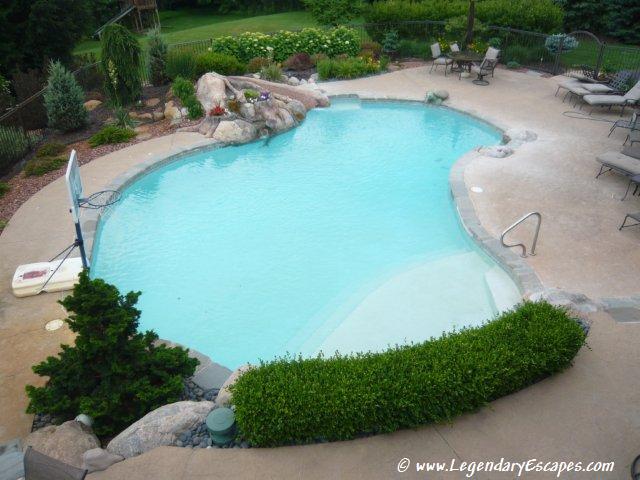Swimming Pool Construction
There are several distinct construction methods for private (home) swimming pools, which are typically called “concrete”, “vinyl liner”, and “fiberglass”. The term “vinyl liner” pool describes the method of lining the interior, not the construction materials, which may be concrete (of various types), pressure-treated wood, or paint-coated or galvanized sheet steel. All construction types have individual benefits and the application depends on the climate, yard conditions and other factors.
Concrete or Gunite Pools
Concrete pools have many different construction methods, as the term concrete describes the basic materials used in construction, and fiberglass refers to the base material of the pool shell which is fiberglass reinforced resin generally 5 mm in thickness. As these terms refer to different parts of the pool the names may be confusing to the newcomer to the swimming pool world. Construction standards for in-ground pools have been developed by the Association of Pool & Spa Professionals (APSP) and approved by the American National Standards Institute.
Concrete pools
A poured-concrete residential pool in may be constructed using many differing methods. Concrete pools are not dissimilar to concrete ships: i.e. they are a contiguous shell that will float under certain circumstances. It is therefore essential that an unrestricted hydrostatic valve is incorporated in the pool design. It is not advisable to empty these pools unnecessarily – especially during rainy months – as the operation of the hydro valve is necessary to avoid flotation (and possible destruction) of the swimming pool. The emptying of all pools must be conducted strictly under the supervision of the pool builder or an authorized consultant.
Vinyl liner pools
As mentioned above, vinyl liner refers only to the interior surface of the pool, as colorized chlorinated PVC thermoplastic vinyl may be used as the waterproofing membrane in a number of diverse pool construction methods. Vinyl Liner pools are typically more numerous than other in-ground pool types, especially so in European Union countries, Canada, England and New Zealand.
They are very popular in the Eastern and Southern United States, where this pool type is considered to be a less expensive option to gunite concrete or referred to as a prefabricated pool that can be quickly installed during a single week, but will still provide a durable, quality product that can last for several decades. Designed by Cascade Industries engineer Bob West and introduced to the New Jersey public in 1948, the package pools were introduced to the wider American public by Cascade’s (c. 1948–1980) VP of sales Ed Gorman by inclusion the 1951 Sears Roebuck catalog as a do-it-yourself project for US$500.00 + delivery and installation.
In the following years many manufacturers worldwide have produced vinyl pool kits of varying styles and quality that can be transported to sites and installed in only a few days. Designs range from simple (and cheap) prefabricated wooden or galvanized steel walls to high-quality concrete sacrificial shutters incorporating foam insulation that are pumped full of high-density shotcrete and remain in place once the concrete has set (as opposed to the wasteful method of using and discarding plywood boxing that gunite and shotcrete pools employ). Vinyl liner pools are popular with many pool buyers due to lower initial cost, better insulation, the many liner patterns and colors available, a child friendly embossed non-slip finish, and the fact that the liners are treated to discourage algae growth. Most chlorinated PVC thermoplastic vinyl pool liners are .20″ and .30″ gauge (.50 mm & .75 mm) and are recyclable when they reach their design life (usually 20 to 25 years in moderate climates). Replacement liners can be installed in one to two days, and providing the basic pool shell is of substantial construction, a pool may have several new liners over its expected life, which could be as much as fifty years in the case of a concrete construction.
